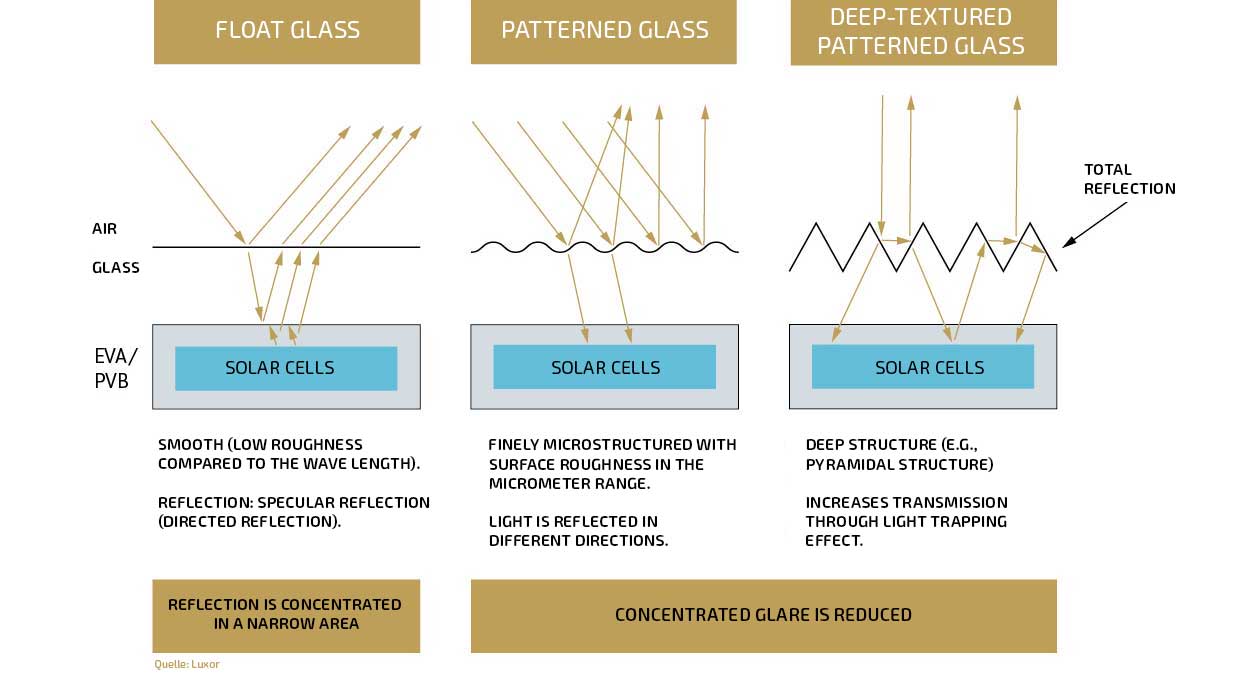

Non-reflective Modules
Purpose and Benefits of Non-Reflective Modules
Glare-free solar panels are essential in locations where unwanted light reflections can become a problem. These panels are used in both residential and commercial settings. In this article, you'll learn what glare is, the technology behind non-reflective solar modules, and how much glare is considered acceptable.
Index
Where to use Glare-Free Solar Panels?
Glare-free solar panels are primarily installed in areas where reflections are either undesirable or potentially hazardous. Key areas of application include:
- Airports and flight paths
- Highways
- Waterways
- Railways
- Protected spaces like residential areas
In these areas, even short periods of glare can cause significant problems, potentially leading to accidents. When building solar installations in these zones, the glare effect is assessed, and safety measures are implemented in advance. In residential areas, while glare from PV panels is rarely dangerous, it can lead to legal disputes between neighbors. Therefore, considering the potential glare effect is recommended during the planning phase.
What is Glare?
Glare from surfaces is measured by their luminance, which is expressed in candelas per square meter (cd/m²). The sun, regardless of the time of day, has a luminance between 6 million cd/m² and 1.6 billion cd/m². For comparison, a blue sky has a luminance of about 8,000 cd/m², while a computer monitor has just 500 cd/m².
Reflection is measured by "albedo," a unitless number representing the ratio of reflected to incoming light. The brighter the surface, the higher the albedo. For example, an albedo of 0.7 means 70% of the light is reflected. By measuring both albedo and luminance, it is possible to determine whether solar panels create problematic glare and if corrective actions are needed.
Legal Considerations
To ensure compliance and avoid legal issues, a "glare assessment" is often required before constructing a PV system, especially if mandated by local authorities. If the assessment indicates excessive glare, the system's design must be adjusted to minimize or eliminate it. This can be done by altering the location, orientation, and tilt of the panels. Other options include installing barriers or using non-reflective solar panels.
In Austria, light pollution regulations are governed by state building codes, although specific thresholds for acceptable levels of glare are not clearly defined. In Germany, the LAI (Federal/State Working Group for Immission Protection) guidelines suggest that glare duration should not exceed 30 minutes per day or 30 hours per year, but these values are not legally binding. In Austria, these same thresholds are outlined in the OVE Guideline R11-3.
Courts have often ruled in favor of solar installation owners, citing an obligation to tolerate certain emissions for the sake of environmental protection. As long as glare is within a tolerable range, it must be accepted.
Types of Glare-Free Solar Panels
Deep-Textured Glass
This type of glass reduces reflection through multiple light scattering. The textured surface creates a "light trap," reflecting light internally rather than externally. This minimizes reflection between the air and glass surface and redirects some light back into the glass, increasing efficiency. Solar panels made with deep-textured glass not only reduce glare but also improve performance, potentially increasing efficiency by up to 2% compared to panels with standard glass. These benefits apply even to systems with east-west orientation.

Satinized and Coated Glass
In addition to deep-textured glass, there are also satinized solar panels, treated with a chemical etching process, and solar panels coated with a special film. Like textured glass, these surfaces scatter light rather than reflecting it directly. However, the long-term effects of these coatings on performance and wear due to environmental exposure are still under study. Satinized and coated panels generally have smoother surfaces compared to deep-textured glass.
Luxor Eco Line Non-Reflect in Our Shop
We offer one glare-free solar panel in our portfolio: the ECO LINE NON-REFLECT N-TYPE M108 from Luxor. This non-reflective module combines reduced glare with highly efficient N-Type TOPCon technology. Manufactured in Asia and Europe, it features thermally tempered anti-reflective glass with a deep texture. Another standout feature is its 25-year performance warranty.
Product Advantages
- Manufactured in Asia and Europe
- Thermally tempered anti-reflective glass
- 25-year performance guarantee
Product Features
- Glass-film module
- Power: 425 Wp
- Monocrystalline N-Type Topcon cells with 16 busbars
- System voltage: 1,500 V
- Glass thickness: 3.2 mm
- Load capacity: 5,400 Pa (snow) / 2,400 Pa (wind)
- Fire protection class: UL 61730 C (UL2703) / II (UL790)
- Dimensions: 1134 x 30 x 1722 mm (WxHxL)
- Weight: 21.5 kg